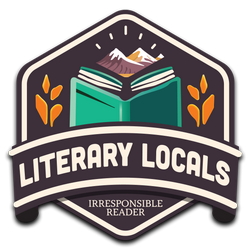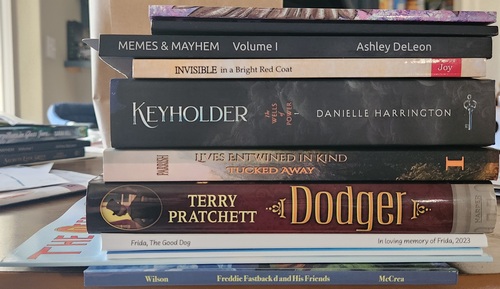
I met Norelle Smith at the Nampa Library’s Book Faire this Spring. She has written so many different kinds of books that I’m not going to try list them–I’d skip something. But…well, I’ll let her get into that.
Before we get into things, why don’t you give the reader a brief introduction to you and your work.
Norelle Smith is my ‘pen name’. Growing up, never had I thought I’d be writing books. As a matter of fact, my 4th grade teacher didn’t think I’d amount to anything. I was slower learning than most kids, but once I caught on, I was on a roll. I graduated from high school with a GPA of 3.8 I love to read as much as I love to write. Let’s get down to my books.
I retired a decade early and I started writing. Why? Well, I shared my life story with a friend one day, her reaction was “Wow, you need to write a book.” But who wants to read a memoir about Norelle Smith? Someone you’ve never heard of! So I decided to write through different characters in different stories. Each book (with the exception of the teen book and children’s books) have a piece of my life in them. Then I built a fictional story around it. Some books have more truth than others, regardless, they’re fiction novels. My hope in writing my story, is not only to entertain the reader but to touch or change a life or two (or more). I’ve walked down some horrible roads, and if my bad choices can help someone else, I’m willing to share most things.
Three of my books are with a co-author, SPW Mitchell, who is also from Emmett Idaho. Wonderful writer. I had no idea what I was doing when I decided to write IF Untold, so he mentored me and we wrote the book together, passing it back and forth to each other. He wrote so well together; we wrote That One Day together as well as Voices in the Dark. We both write our novels independently now. He has his hands in other things while writing. He’s starting to write, produce and direct short films. I’m very excited for him.
I have three other books that I wrote solo – The Gap Between Us, Viola and Deceitful Hearts, which should be available September 1st. And more to come.
My books are available on Amazon, as well as my website – norellesmithbooks.com
Are you a native Idahoan? What brought you to Idaho in the first place? (answer whichever question applies) What is it about Idaho that keeps you here?
I’m not a native Idahoan, however, I have been here for several decades. Almost right out of high school (and trust me, that’s a long time ago!) I married (too) young, and when I came here, I was married to a guy that has Idaho roots for many generations. His great great-grandfather was an Idaho State Senator back in the 1950’s, if I remember right. They were one of the early families in the town of Council as well. What keeps me here? I’ve been here most of my life. This is where my daughters and grandkids are. And I’m now married to a man who is a native of Emmett, Idaho, which is where I live. He also has roots here back generations. We even have a road here in Emmett named after his grandmother’s side of the family: Vanderdasson Rd. The weather is great, I love having all four seasons. Although, I’m a summer girl and wish summer would last a little longer. I’m surrounded by everything: the river, the mountains and the forest are right behind me. Many lakes are a short drive away. And if I need to drive into the city, it’s just over the hill. With all of that, why leave?
Are you tied into some sort of local author/bookish group/culture? If so, tell us about it and how it helps you as an author. If you’re not, is there a reason for it?
I’m not tied to any local author group; however, I do have some other local authors that I’m friends with. I would love to participate with one/or more of the groups, but honestly the only thing that keeps me from it is my writing schedule. Typically, I’m up about 1 or 1:30 am, and start writing. When the rest of the world is still sleeping, although this morning I did sleep in. Until 3am  . I’ve been asked many times why I write that early. Simple: It’s quiet and there are no distractions – and I get distracted easily! During the summer when the nights stay hot, I’ve been known to write outside under the stars. THAT is wonderful. Many ideas come on those nights, when I sit back and let my mind wonder. (So if there are any local groups that meet in the morning or early/midafternoon, please let me know. I’ll be there!)
. I’ve been asked many times why I write that early. Simple: It’s quiet and there are no distractions – and I get distracted easily! During the summer when the nights stay hot, I’ve been known to write outside under the stars. THAT is wonderful. Many ideas come on those nights, when I sit back and let my mind wonder. (So if there are any local groups that meet in the morning or early/midafternoon, please let me know. I’ll be there!)
What kind of events in the area do you attend—either to sell/promote your books or to network with authors? Are there any outside of this area that you hit regularly and wish we had something like it here?
In terms of local events, I’ve done several book signings and library local author promotions. I also enjoy going to holiday bazaars and craft sales, whether I sell just a few books or dozens, talking with people at those is always fun. I’m eager to attend some out of the area. It’s interesting that it’s so enjoyable for me, because I’m an introvert and a homebody. Probably most writers are, maybe that’s why we talk on paper so easily. I’m working on a new children’s book series with a man named Bill Atalla. Once those books launch, I expect to be going out of the area to promote not only those books, but the ones that I’ve already written as well. More to come on that series.
Follow us on the website – theunlikelycrew.com
It will be launching soon, and Bill and I will be making one or more videos to launch the series. It’s funny how we met.
What’s the breakdown of your audience—do you have a strong local base, or are your readers from other parts of the world?
I thought that most of my readers would be local, but I’m finding that not to be true. I was surprised when I had a review on the amazon page from the UK for my first book, IF Untold.
Do you think there are particular challenges or advantages to being a writer in the Treasure Valley? (possibly both)
I don’t think living in the Treasure Valley has either challenges or advantages. With my laptop, I can write from anywhere. Often, I write when I’m waiting in the parking lot to pick up my grandkids from school. I believe any challenges that I have fall on me, I’m still learning and improving my writing. Also, trying to figure out the marketing side of being a writer. The marketing side is the most challenging part, not my location. I must say, it’s incredible how supportive the Treasure Valley community and libraries are of local authors.
Do you bring Idaho (or some sort of Idaho-sensibility, assuming one exists) to your work? Whether or not anyone else sees it, can you look at some aspect of your writing and think “That’s Idaho” or “I would do ____ differently if I was a Kentuckian or from Illinois?”
I don’t (or at least haven’t yet) mentioned Idaho in my books. Horses and small-town living are mentioned in a couple, but there are two books that you don’t see much of the content in the rural communities (at least not where I live), so I decided not to. Now that doesn’t mean I won’t change it up later  And yes, there are two local authors that I know of that do mention Idaho in their books, one in particular has Idaho towns mentioned in every book that I’ve read of hers. I’m a big fan and have had the opportunity to do a book signing with her and meet with her for coffee.
And yes, there are two local authors that I know of that do mention Idaho in their books, one in particular has Idaho towns mentioned in every book that I’ve read of hers. I’m a big fan and have had the opportunity to do a book signing with her and meet with her for coffee.
One final question, is there a book (or two…or 18, if you get really carried away), that embodies Idaho/the Idaho spirit to you to recommend to my readers?
The list is too long to mention individual books so how about two authors – Duane Peterson is a local author (I believe he passed away end of last year). He lived in Emmett but was originally from Cascade. He wrote several history books about Valley County, and he has more than a dozen western novels (fiction). The second is Robin Lee Hatcher, who I mentioned above. Robin writes Christian Fiction romance. Most of the books I’ve read she’s written the story in Idaho towns. Both are incredible writers!
Thanks for your time and participation! Hope you enjoyed it!


















 . I’ve been asked many times why I write that early. Simple: It’s quiet and there are no distractions – and I get distracted easily! During the summer when the nights stay hot, I’ve been known to write outside under the stars. THAT is wonderful. Many ideas come on those nights, when I sit back and let my mind wonder. (So if there are any local groups that meet in the morning or early/midafternoon, please let me know. I’ll be there!)
. I’ve been asked many times why I write that early. Simple: It’s quiet and there are no distractions – and I get distracted easily! During the summer when the nights stay hot, I’ve been known to write outside under the stars. THAT is wonderful. Many ideas come on those nights, when I sit back and let my mind wonder. (So if there are any local groups that meet in the morning or early/midafternoon, please let me know. I’ll be there!)